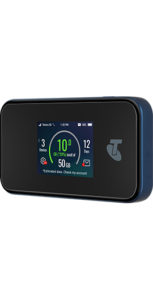Telstra’s latest Mi-Fi router ticks the boxes for future-proof operation
Article 
Telstra now have a mmWave-capable 5G hotspot | PC World
From the horse’s mouth
Telstra
Telstra 5G Wi-Fi Pro router
Product Page – has latest pricing and mobile-broadband service contracts
5G mmWave Mobile Broadband Technology
My Comments
Telstra has fronted up with their latest premium portable mobile broadband router for the 5G mobile-broadband infrastructure. But this “Mi-Fi” known as the Telstra 5G Wi-Fi Pro ticks all the boxes as far as being future-proof is concerned.
Here, on the WAN (Internet) side, this device supports 5G with mmWave technology while on the LAN (local network) side, it works on the latest Wi-Fi 6 standard for 2.4GHz and 5GHz bands thus bringing your mobile network up to date with the latest standards.Of course it can work with existing 4G LTE networks and exploits what Telstra has to offer in this context. This has a 4500mAh battery that can be removed and can run for nine hours providing full data transfer. It can be charged via a USB-C connection according to the QC 3.0 protocol and the open-frame Power Delivery 2.0 protocol, meaning you can charge it with your brand-new Ultrabook’s charger or run it for a long time using a USB-C PD powerbank.
The Telstra 5G Wi-Fi Pro costs AUD$599 straight up. Or you could buy this device on a post-paid Telstra service plan for AUD$24.95 / month on 24-month plan plus mobile data plan the cost of the mobile-broadband data service.
What is this mmWave 5G mobile broadband all about?
The mmWave 5G mobile broadband technology is an extremely-high-frequency variant of 5G mobile broadband technology which works between 24GHz to 100GHz. Telstra’s initial trial run of this technology at Gold Coast worked on 26GHz. The same technology has been sued with various fixed point-to-point wireless links and satellite-Internet services but is use as a mobile broadband technology is what is being identified here.
Due to the very short wavelength, mmWave 5G technology will have a short operating range of a few hundred metres from the base station. This means that to cover a significant area, the service provider will need to install many “femtocell” base stations across the area and they will typically operate at a signal strength similar to a Wi-Fi access point or router. It means that the electromagnetic energy levels are 1000 times below the maximum energy level expected for safe operation.
Therefore mmWave 5G technology is pitched for operating environments where there is a high concentration of users so as to avoid “loading” very few base stations with many users, thus denying the users adequate bandwidth. This is a situation most of us will have experienced when attempting to benefit from an Internet resource on our mobile devices while on a packed commuter train.
Here, you will see this technology be used at busy public-transport interchanges including airports; event venues like convention centres or sports stadiums; or shopping centres. You may even find it being used in high-rise residential, commercial and hotel developments where there is expected to be many people within the development.
At the moment, Telstra has to license the necessary spectrum in order to set up a mmWave 5G service and will need to see other devices come on board prepared for this technology.
mmWave 5G mobile broadband will simply be pressed in to service as a complementary technology to the existing 5G mobile broadband technologies. In this case it is about highly-concentrated operating environments with many devices.
